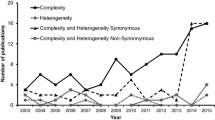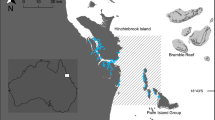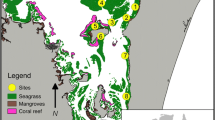Abstract
Quantifying physical heterogeneity is essential for meaningful ecological research and effective resource management. Spatial patterns of multiple, co-occurring physical features are rarely quantified across a seascape because of methodological challenges. Here, we identified approaches that measured total site-specific heterogeneity, an often overlooked aspect of estuarine ecosystems. Specifically, we examined 23 metrics that quantified four types of common physical features: (1) river and creek confluences, (2) bathymetric variation including underwater drop-offs, (3) land features such as islands/sandbars, and (4) major underwater channel networks. Our research at 40 sites throughout Plum Island Estuary (PIE) provided solutions to two problems. The first problem was that individual metrics that measured heterogeneity of a single physical feature showed different regional patterns. We solved this first problem by combining multiple metrics for a single feature using a within-physical feature cluster analysis. With this approach, we identified sites with four different types of confluences and three different types of underwater drop-offs. The second problem was that when multiple physical features co-occurred, new patterns of total site-specific heterogeneity were created across the seascape. This pattern of total heterogeneity has potential ecological relevance to structure-oriented predators. To address this second problem, we identified sites with similar types of total physical heterogeneity using an across-physical feature cluster analysis. Then, we calculated an additive heterogeneity index, which integrated all physical features at a site. Finally, we tested if site-specific additive heterogeneity index values differed for across-physical feature clusters. In PIE, the sites with the highest additive heterogeneity index values were clustered together and corresponded to sites where a fish predator, adult striped bass (Morone saxatilis), aggregated in a related acoustic tracking study. In summary, we have shown general approaches to quantifying site-specific heterogeneity.






Similar content being viewed by others
References
Able, K., T. Grothues, J. Turnure, D.M. Byrne, and P. Clerkin. 2012. Distribution, movements, and habitat use of small striped bass (Morone saxatilis) across multiple spatial scales. Fishery Bulletin 110: 176–192.
Ajemian, M.J., and S.P. Powers. 2016. Seasonality and ontogenetic habitat partitioning of cownose rays in the northern Gulf of Mexico. Estuaries and Coasts 39: 1234–1248.
Andrew, N.L. 1993. Spatial heterogeneity, sea-urchin grazing, and habitat structure on reefs in temperate Australia. Ecology 74: 292–230.
Angermeier, P., and I. Schlosser. 1989. Species-area relationship for stream fishes. Ecology 70: 1450–1462.
Anlauf, K.J., D.W. Jensen, K.M. Burnett, E.A. Steel, K. Christiansen, J.C. Firman, B.E. Feist, and D.P. Larsen. 2011. Explaining spatial variability in stream habitats using both natural and management-influenced landscape predictors. Aquatic Conservation: Marine and Freshwater Ecosystems 21: 704–714.
Arakida, H., H. Mitsuhashi, M. Kamada, and K. Koyama. 2011. Mapping the potential distribution of shorebirds in Japan: the importance of landscape-level coastal geomorphology. Aquatic Conservation: Marine and Freshwater Ecosystems 21: 553–563.
Ardron, J. A., J. Lash, and D. Haggarty. 2002. Modeling a network of marine protected areas for the central coast of British Columbia. Version 3.1. Living Oceans Society, Sointula, BC, Canada.
Attrill, M.J., J.A. Strong, and A.A. Rowden. 2000. Are macroinvertebrate communities influenced by seagrass structural complexity? Ecography 23: 114–121.
Benda, L., N.L. Poff, D. Miller, T. Dunne, G. Reeves, G. Pess, and M. Pollock. 2004. The network dynamics hypothesis: how channel networks structure riverine habitats. Bioscience 54: 413.
Bjorgo, K.A., J.J. Isely, and C.S. Thomason. 2000. Seasonal movement and habitat use by striped bass in the Combahee River, South Carolina. Transactions of the American Fisheries Society 129: 1281–1287.
Boström, C., S.J. Pittman, C. Simenstad, and R.T. Kneib. 2011. Seascape ecology of coastal biogenic habitats: advances, gaps, and challenges. Marine Ecology Progress Series 427: 191–217.
Botto, F., A. Mendez-Casariego, M. Valinas, and O. Iribarne. 2008. Spatial heterogeneity created by burrowing crabs affects human impact on migratory shorebirds. Estuaries and Coasts 31: 134–143.
Brooks, K.L., H.L. Mossman, J.L. Chitty, and A. Grant. 2015. Limited vegetation development on a created salt marsh associated with over-consolidated sediments and lack of topographic heterogeneity. Estuaries and Coasts 38: 325–336.
Catano, L.B., M.C. Rojas, R.J. Malossi, J.R. Peters, M.R. Heithaus, J.W. Fourqurean, and D.E. Burkepile. 2016. Reefscapes of fear: predation risk and reef heterogeneity interact to shape herbivore foraging behavior. Journal of Animal Ecology 85: 146–156.
Cheek, B.D., T.B. Grabowski, P.T. Bean, J.R. Groeschel, and S.I. Magnelia. 2016. Evaluating habitat associations of a fish assemblage at multiple spatial scales in a minimally disturbed stream using low-cost remote sensing. Aquatic Conservation-Marine and Freshwater Ecosystems 26: 20–34.
Clark, R.D., J.D. Christensen, M.E. Monaco, P.A. Caldwell, G.A. Matthews, and T.J. Minello. 2004. A habitat-use model to determine essential fish habitat for juvenile brown shrimp (Farfantepenaeus aztecus) in Galveston Bay. Texas. Fishery Bulletin. 102: 264–277.
Dambach, J., and D. Rödder. 2011. Applications and future challenges in marine species distribution modeling. Aquatic Conservation: Marine and Freshwater Ecosystems 21: 92–100.
Deegan, L.A., and R.H. Garritt. 1997. Evidence for spatial variability in estuarine food webs. Marine Ecology Progress Series 147: 31–47.
de Jong, M.F., M.J. Baptist, R. van Hal, I.J. de Boois, H.J. Lindeboom, and P. Hoekstra. 2014. Impact on demersal fish of a large-scale and deep sand extraction site with ecosystem-based landscaped sandbars. Estuarine Coastal and Shelf Science 146: 83–94.
Diehl, S. 1992. Fish predation and benthic community structure—the role of omnivory and habitat complexity. Ecology 73: 1646–1661.
Downes, B.J., P.S. Lake, E.S.G. Schreiber, and A. Glaister. 1998. Habitat structure and regulation of local species diversity in a stony, upland stream. Ecological Monographs 68: 237–257.
Esselman, P., D. Infante, and L. Wang. 2011. An index of cumulative disturbance to river fish habitats of the conterminous United States from landscape anthropogenic activities. Ecological Restoration 29: 1–2.
Fausch, K.D., C.E. Torgersen, C.V. Baxter, and H.W. Li. 2002. Landscapes to riverscapes: bridging the gap between research and conservation of stream fishes. Bioscience 52: 483.
Ferry, K.H., and M.E. Mather. 2012. Spatial and temporal diet patterns of subadult and small adult striped bass in Massachusetts estuaries: data, a synthesis, and trends across scales. Marine and Coastal Fisheries 4: 30–45.
França, S., R.P. Vasconcelos, V.F. Fonseca, S.E. Tanner, P. Reis-Santos, M.J. Costa, and H.N. Cabral. 2012. Predicting fish community properties within estuaries: influence of habitat type and other environmental features. Estuarine, Coastal and Shelf Science 107: 22–31.
Gorman, O.T., and J.R. Karr. 1978. Habitat structure and stream fish communities. Ecology 59: 507–515.
Gratwicke, B., and M.R. Speight. 2005. The relationship between fish species richness, abundance and habitat complexity in a range of shallow tropical marine habitats. Journal of Fish Biology 66: 650–667.
Gray, C.A., D. Rotherham, and D. Johnson. 2011. Consistency of temporal and habitat-related differences among assemblages of fish in coastal lagoons. Estuarine Coastal and Shelf Science 95: 401–414.
Guisan, A., and W. Thuiller. 2005. Predicting species distribution: offering more than simple habitat models. Ecology Letters 8: 993–1009.
Hennig, C. 2010. Flexible procedures for clustering. R package version 2.0–3
Horan, D., J. Kershner, and C. Hawkins. 2000. Effects of habitat area and complexity on Colorado River cutthroat trout density in Uinta Mountain streams. Transactions of the American Fisheries Society 129: 1250–1263.
Jungwirth, M., S. Muhar, and S. Schmutz. 2000. Fundamentals of fish ecological integrity and their relation to the extended serial discontinuity concept. Hydrobiologia 422: 85–97.
Kennedy, C.G., M.E. Mather, J.M. Smith, J.T. Finn, and L.A. Deegan. 2016. Discontinuities concentrate mobile predators: quantifying organism-environment interactions at a seascape scale. Ecosphere 7(2): e01226. doi:10.1002/ecs2.1226.
Kiffney, P.M., C.M. Greene, J.E. Hall, and J.R. Davies. 2006. Tributary streams create spatial discontinuities in habitat, biological productivity, and diversity in mainstem rivers. Canadian Journal of Fisheries and Aquatic Sciences 63: 2518–2530.
Kolasa, J., and C.D. Rollo. 1991. The heterogeneity of heterogeneity: a glossary. In Ecological heterogeneity, ed. J. Kolasa and S. Pickett, 1–23. New York: Springer.
Kovalenko, K.E., S.M. Thomaz, and D.M. Warfe. 2011. Habitat complexity: approaches and future directions. Hydrobiologia 685: 1–17.
Lathrop, R.G., M. Cole, N. Senyk, and B. Butman. 2006. Seafloor habitat mapping of the New York bight incorporating sidescan sonar data. Estuarine Coastal and Shelf Science 68: 221–230.
Li, H., and J.F. Reynolds. 1995. On definition and quantification of heterogeneity. Oikos 73: 280–284.
Loke, L.H., R.J. Ladle, T.J. Bouma, and P.A. Todd. 2015. Creating complex habitats for restoration and reconciliation. Ecological Engineering 77: 307–313.
Lund, K., and A. R. Wilbur. 2007. Habitat classification feasibility study for coastal and marine environments in Massachusetts. Massachusetts Office of Coastal Zone Management. Boston, MA.
Madden, C.J., D.H. Grossman, and K.L. Goodin. 2005. Coastal and marine systems of North America: framework for an ecological classification standard: version II. Arlington, Virginia: NatureServe.
Maddock, I. 1999. The importance of physical habitat assessment for evaluating river health. Freshwater Biology 41: 373–391.
Maechler, M., P. Rousseeuw, A. Struyf, and M. Hubert. 2005. Cluster analysis basics and extensions.
Mather, M.E., J.T. Finn, K.H. Ferry, L.A. Deegan, and G.A. Nelson. 2009. Use of non-natal estuaries by migratory striped bass (Morone saxatilis) in summer. Fishery Bulletin 107: 329–338.
Mather, M.E., J.T. Finn, S.M. Pautzke, D. Fox, T. Savoy, H.M. Brundage III, L.A. Deegan, and R.M. Muth. 2010. Destinations, routes, and timing of adult striped bass on their southward fall migration: implications for coastal movements. Journal of Fish Biology 77: 2326–2337.
Mather, M.E., J.T. Finn, C.G. Kennedy, L.A. Deegan, and J.M. Smith. 2013. What happens in an estuary does not stay there: patterns of biotic connectivity resulting from long term ecological research. Oceanography 26: 168–179.
MacDonald, J.A., T. Glover, and J.S. Weis. 2008. The impact of mangrove prop-root epibionts on juvenile reef fishes: a field experiment using artificial roots and epifauna. Estuaries and Coasts 31: 981–993.
Naiman, R.J., H. Decamps, J. Pastor, and C.A. Johnston. 1988. The potential importance of boundaries of fluvial ecosystems. Journal of the North American Benthological Society 7: 289–306.
Nash, K.L., C.R. Allen, D.G. Angeler, C. Barichievy, T. Eason, A.S. Garmestani, N.A.J. Graham, D. Granholm, M. Knutson, R.J. Nelson, M. Nyström, C.A. Stow, and S.M. Sundstrom. 2014. Discontinuities, cross-scale patterns, and the organization of ecosystems. Ecology 95: 654–667.
Newcomb, T.J., D.J. Orth, and D.F. Stauffer. 2007. Habitat evaluation. In Analysis and interpretation of freshwater fisheries data, ed. C.S. Guy and M.L. Brown, 843–886. Bethesda, MD: American Fisheries Society.
Ng, C.L., K.W. Able, and T.M. Grothues. 2007. Habitat use, site fidelity, and movement of adult striped bass in a Southern New Jersey estuary based on mobile acoustic telemetry. Transactions of the American Fisheries Society 136: 1344–1355.
Ock, G., D. Gaeuman, J. McSloy, and G. Kondolf. 2015. Ecological functions of restored gravel bars, the Trinity River, California. Ecological Engineering 83: 49–60.
Osawa, T., H. Mitsuhashi, H. Niwa, and A. Ushimaru. 2011. The role of river confluences and meanderings in preserving local hot spots for threatened plant species in riparian ecosystems. Aquatic Conservation: Marine and Freshwater Ecosystems 21: 358–363.
Paller, M.H., B.A. Prusha, D.E. Fletcher, E. Kosnicki, S.A. Sefick, M.S. Jarrell, S.C. Sterrett, A.M. Grosse, T.D. Tuberville, and J.W. Feminella. 2016. Factors influencing stream fish species composition and functional properties at multiple spatial scales in the sand hills of the southeastern United States. Transactions of the American Fisheries Society 145: 545–562.
Palmer, M., and N. Poff. 1997. The influence of environmental heterogeneity on patterns and processes in streams. Journal of the North American Benthological Society 16: 169–173.
Pautzke, S.M., M.E. Mather, J.T. Finn, L.A. Deegan, and R.M. Muth. 2010. Seasonal use of a New England estuary by foraging contingents of migratory striped bass. Transactions of the American Fisheries Society 139: 257–269.
Peipoch, M., M. Brauns, F.R. Hauer, M. Weitere, and H.M. Valett. 2015. Ecological simplification: human influences on riverscape complexity. Bioscience: 1057–1065.
Pittman, S.J. 2013. Seascape ecology. Marine Scientist 44: 20–23.
Poole, G.C. 2002. Fluvial landscape ecology: addressing uniqueness within the river discontinuum. Freshwater Biology 47: 641–660.
Poole, G.C. 2010. Stream hydrogeomorphology as a physical science basis for advances in stream ecology. Journal of the North American Benthological Society 29: 12–25.
Pretty, J.L., S.S.C. Harrison, D.J. Shepherd, C. Smith, A.G. Hildrew, and R.D. Hey. 2003. River rehabilitation and fish populations: assessing the benefit of instream structures. Journal of Applied Ecology 40: 251–265.
R Development Core Team. 2010. R: a language and environment for statistical computing. R Foundation for Statistical Computing, Vienna, Austria. ISBN 3–900051–07-0, URL http://www.R-project.org.
Rice, S.P., R.I. Ferguson, and T.B. Hoey. 2006. Tributary control of physical heterogeneity and biological diversity at river confluences. Canadian Journal of Fisheries and Aquatic Sciences 63: 2553–2566.
Robinson, J.L., and P.S. Rand. 2005. Discontinuity in fish assemblages across an elevation gradient in a southern Appalachian watershed, USA. Ecology of Freshwater Fish 14: 14–23.
Rosenberg, A., T.E. Bigford, S. Leathery, R.L. Hill, and K. Bickers. 2000. Ecosystem approaches to fishery management through essential fish habitat. Bulletin of Marine Science 66: 535–542.
Scheiner, S., and M. Willig. 2008. A general theory of ecology. Theoretical Ecology 1: 21–28.
Smith, J.M., and M.E. Mather. 2013. Beaver dams maintain fish biodiversity by increasing habitat heterogeneity throughout a low-gradient stream network. Freshwater Biology 58: 1523–1538.
Stanford, J., and J.V. Ward. 2001. Revisiting the serial discontinuity concept. Regulated Rivers: Research and Management 17: 303–310.
Tang, L., Y. Gao, C.H. Wang, B. Li, J.K. Chen, and B. Zhao. 2013. Habitat heterogeneity influences restoration efficacy: implications of a habitat-specific management regime for an invaded marsh. Estuarine Coastal and Shelf Science 125: 20–26.
Tews, J., U. Brose, V. Grimm, K. Tielbörger, M.C. Wichmann, M. Schwager, and F. Jeltsch. 2004. Animal species diversity driven by habitat heterogeneity/diversity: the importance of keystone structures. Journal of Biogeography 31: 79–92.
Tokeshi, M., and S. Arakaki. 2012. Habitat complexity in aquatic systems: fractals and beyond. Hydrobiologia 685: 27–47.
Tupper, M., and K.W. Able. 2000. Movements and food habits of striped bass (Morone saxatilis) in Delaware Bay (USA) salt marshes: comparison of a restored and a reference marsh. Marine Biology 137: 1049–1058.
Vallino, J.J., C.S. Hopkinson, and R.H. Garritt. 2005. Estimating estuarine gross production, community respiration and net ecosystem production: a nonlinear inverse technique. Ecological Modelling 187: 281–296.
Visintainer, T.A., S.M. Bollens, and C. Simenstad. 2006. Community composition and diet of fishes as a function of tidal channel geomorphology. Marine Ecology Progress Series 321: 227–243.
Wallis, E., R. Mac Nally, and P. S. Lake. 2008. A Bayesian analysis of physical habitat changes at tributary confluences in cobble-bed upland streams of the Acheron River basin, Australia. Water
Ward, J.V., and J. Stanford. 1983. The serial discontinuity concept of lotic ecosystems. Dynamics of lotic ecosystems 10: 29–42.
Winemiller, K.O., A.S. Flecker, and D.J. Hoeinghaus. 2010. Patch dynamics and environmental heterogeneity in lotic ecosystems. Journal of the North American Benthological Society 29: 84–99.
Acknowledgements
The Kansas Cooperative Fish and Wildlife Research Unit (Kansas State University, the US Geological Survey, US Fish and Wildlife Service, the Kansas Department of Wildlife, Parks, and Tourism, and the Wildlife Management Institute) provided support during manuscript preparation. The University of Massachusetts at Amherst and the University of Massachusetts School of Marine Sciences, especially Robert Gamache, provided financial support. The Plum Island Ecosystems LTER program (OCE-0423565, OCE-1058747, OCE-1238212) provided lodging and field assistance. Invaluable field, laboratory, and other assistance were provided by members of the University of Massachusetts and Kansas State University fish ecology groups. D. Beauchamp and two anonymous reviewers provided useful comments. Any use of trade, product, or firm names is for descriptive purposes only and does not imply endorsement by the US Government. This research was conducted under the auspices of University of Massachusetts IACUC Protocol no. 28-02-15; 2012-0023.
Author information
Authors and Affiliations
Corresponding author
Additional information
Communicated by Carl T. Friedrichs
Rights and permissions
About this article
Cite this article
Kennedy, C.G., Mather, M.E. & Smith, J.M. Quantifying Site-Specific Physical Heterogeneity Within an Estuarine Seascape. Estuaries and Coasts 40, 1385–1397 (2017). https://doi.org/10.1007/s12237-016-0207-9
Received:
Revised:
Accepted:
Published:
Issue Date:
DOI: https://doi.org/10.1007/s12237-016-0207-9




